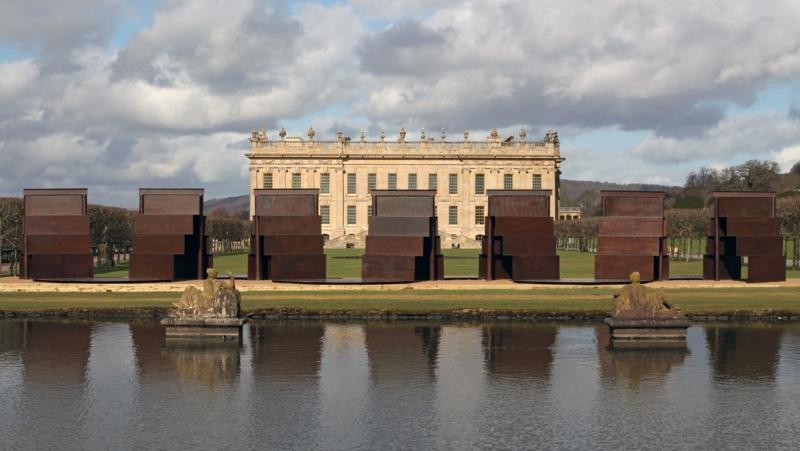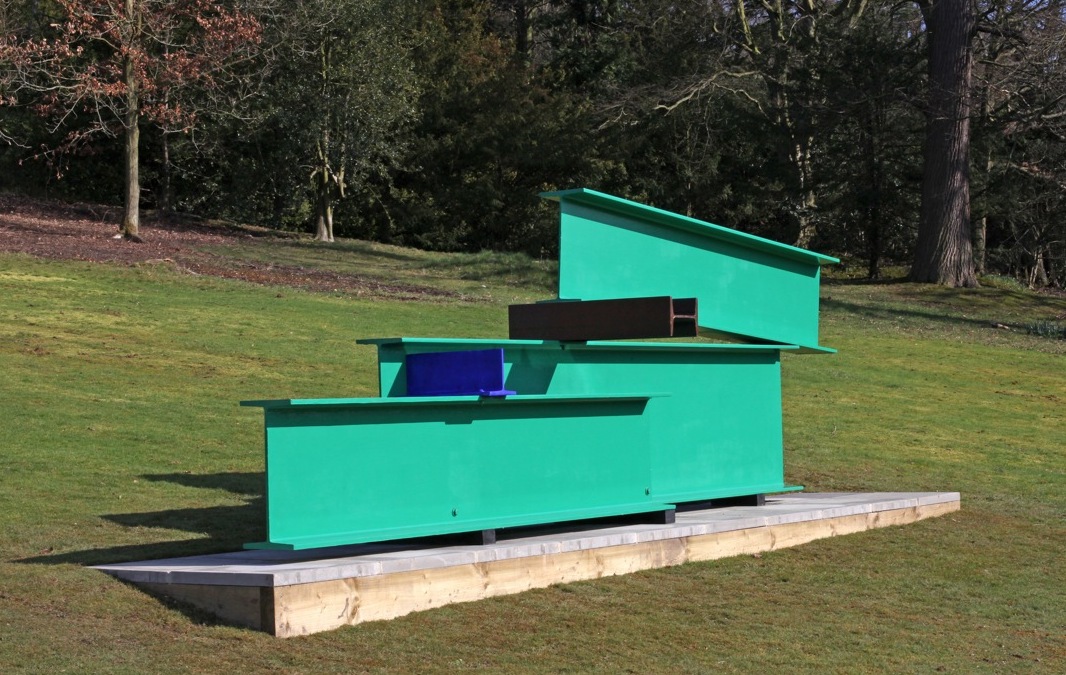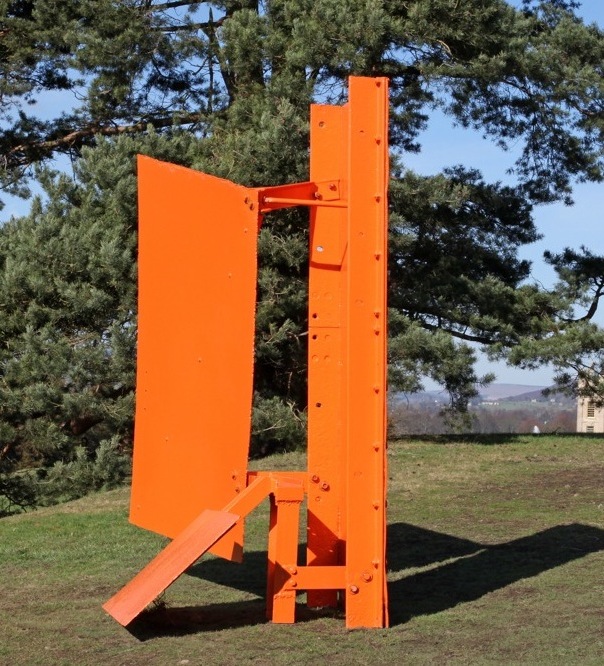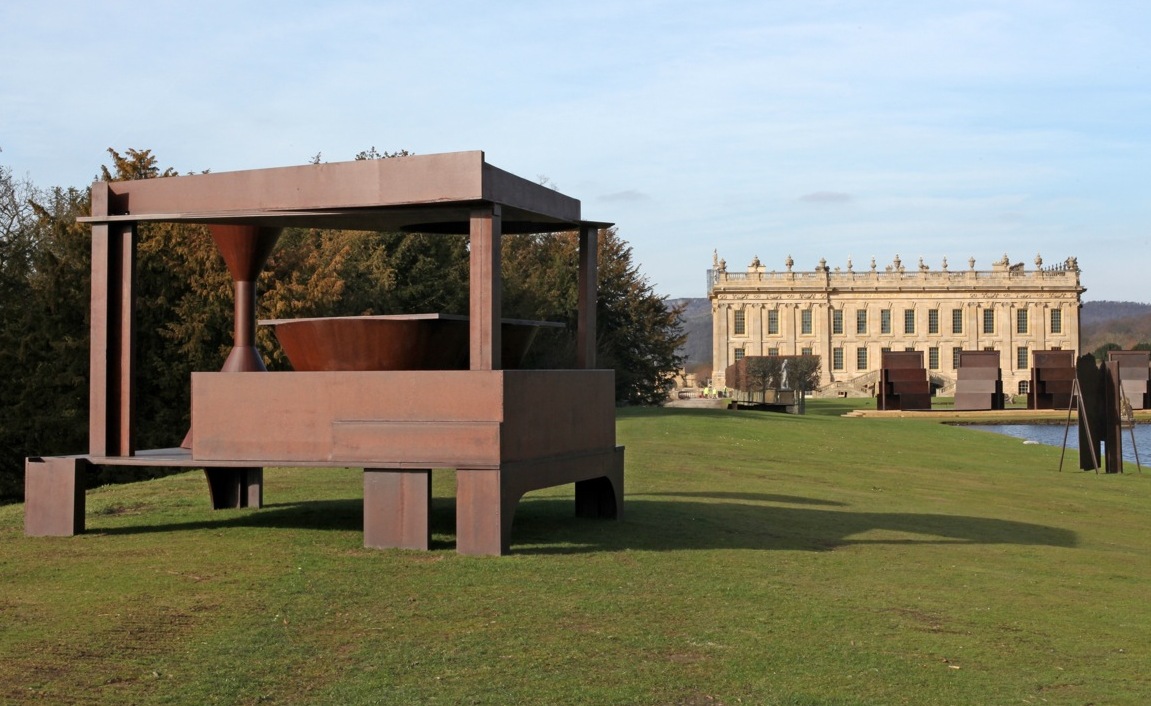Caro at Chatsworth, Chatsworth House | reviews, news & interviews
Caro at Chatsworth, Chatsworth House
Caro at Chatsworth, Chatsworth House
Brilliantly choreographed and vividly memorable, Caro's monumental sculptures shine in an outdoor setting

The first and most unusual aspect of Caro at Chatsworth is that it is there: 15 outstanding sculptures by Sir Anthony Caro, placed in an irregular pattern around the formal 950ft early-18th-century Canal Pond, situated facing the southern vista of the great Baroque house. For these sculptures are tough, the antithesis of any sentimental attachment to a rural Arcadia, almost relentlessly urban and even architectural. Caro once used the term "archisculpture" for his ambitious work.
Caro objects to being called a living national treasure or any such sobriquet, although at the age of 88 it comes with the territory: he is a relentless worker, an untiring explorer of forms and materials, and a remarkable innovator. And he is against gush, in person and in his art. His rampant originality is more than clear in this selection of work from the 1960s to now, in which his fascination with varied finishes, forms and moods – from playful to grand, from colourful to sombre – is given full rein. Every work rises from the ground: Caro dispensed long ago with the plinth, once so inescapably paired with sculptural work. And Caro uses steel - painted, stainless, varnished, rusted – its industrial origins often visible.
Caro’s sculptures are grand, but also approachable, huge but also paradoxically human in scale
This is the first major exhibition of contemporary work devoted to a single artist that Chatsworth has held, although it is a fascinating policy of the Trust to mix in contemporary decorative and fine arts in the historic settings of the “Palace of the Peaks”: we find two Edmund de Waal installations in the fireplaces down one corridor, and a Caro table top in the Victorian sculpture gallery. And just before the vast shop and exit from the house itself there is a small three-room gallery, currently occupied by a sampling of the 20th-century British art holdings of the Frank Cohen collection. In the past few years there have been outdoor sculpture anthologies organised by Sotheby’s: the 12th Duke of Devonshire is a director. To show contemporary work in such an improbable setting makes it both refreshing and surprisingly approachable, reminding us that the historic was once the contemporary.
 Chatsworth has 800,000 visitors during its season, so there is a big and possibly unsuspecting audience for this coherent essay on just what makes Caro Caro. The six massive ziggurats of Goodwood Steps in varnished steel (1996) stands as a series of linked gateways, and signifiers, at the foot of the Canal Pond. Yet Goodwood Steps is also airy and open. Caro’s sculptures are grand, but also almost alarmingly approachable, huge but also paradoxically human in scale.
Chatsworth has 800,000 visitors during its season, so there is a big and possibly unsuspecting audience for this coherent essay on just what makes Caro Caro. The six massive ziggurats of Goodwood Steps in varnished steel (1996) stands as a series of linked gateways, and signifiers, at the foot of the Canal Pond. Yet Goodwood Steps is also airy and open. Caro’s sculptures are grand, but also almost alarmingly approachable, huge but also paradoxically human in scale.
 Caro’s very early work was figurative - he was devoted to drawing and the life class - and wonderfully sensual before he plunged half a century ago so whole-heartedly into abstraction. His sculptures are not totemic, anthropomorphic, or reminiscent of the human form, but they are lively and curiously animated, brilliantly choreographed and vividly memorable. Capital, 1960 (pictured right), steel painted orange, consists of several upright slabs of metal standing on a group of supports with several extensions, almost like limbs, as though the whole thing were about to take off and dance down the lawn. Nearby is Sculpture Seven, 1961 (pictured above), irregularly stacked and layered beams, painted green, blue and brown, a series of steps at various angles leading nowhere except into the visitor’s imagination. Double Tent, 1987-1993, is a series of linked geometric forms at all sorts of angles, a kind of vocabulary of non-objective art, scallops, circles, rods, discs, slabs, all in shining silvery stainless steel, aglow in the natural light.
Caro’s very early work was figurative - he was devoted to drawing and the life class - and wonderfully sensual before he plunged half a century ago so whole-heartedly into abstraction. His sculptures are not totemic, anthropomorphic, or reminiscent of the human form, but they are lively and curiously animated, brilliantly choreographed and vividly memorable. Capital, 1960 (pictured right), steel painted orange, consists of several upright slabs of metal standing on a group of supports with several extensions, almost like limbs, as though the whole thing were about to take off and dance down the lawn. Nearby is Sculpture Seven, 1961 (pictured above), irregularly stacked and layered beams, painted green, blue and brown, a series of steps at various angles leading nowhere except into the visitor’s imagination. Double Tent, 1987-1993, is a series of linked geometric forms at all sorts of angles, a kind of vocabulary of non-objective art, scallops, circles, rods, discs, slabs, all in shining silvery stainless steel, aglow in the natural light.

Colour vanishes, replaced by the look of naturally rusted steel, weathered with time, in several works, particularly in a series called Flats: the horizontal is ever more emphasised, all the slabs bolted and riveted together and perching on various steps and platforms which are part of the composition. Forum from the 1990s flexes the geometric aesthetic, whilst Egyptian 1999-2001 (pictured above), is a huge enclosed structure like a house we cannot enter yet conveying not a sense of the impregnable but a feeling of security and confidence.
Caro emerges as the master player still making new moves in the art game
The totality is surprising: these sculptures all together are joyful and witty, and stretch out as though parading their muscles with pleasure: cats or even lions in the sun. Being outdoors, rather than the unvarying illumination of the white cubes of rooms in galleries, has brought the benefit of changing light, emphasising variations in texture, colour, surface, offering us sun and shadow. We literally see them anew. These huge pieces glint and gleam and generally disport themselves. Caro emerges as the master player still making new moves in the art game.
- Caro at Chatsworth at Chatsworth House until 1 July
- There are several related exhibitions: Bronzes from the House series at the Yorkshire Sculpture Park until 1 July; Anthony Caro Reliefs and Standing Sculpture, Roche Court, New Art Centre, 21 April to 24 June; and an early work, Woman Waking Up, 1956, will be on view at The Hepworth, Wakefield next month
rating
Share this article
The future of Arts Journalism
You can stop theartsdesk.com closing!
We urgently need financing to survive. Our fundraising drive has thus far raised £49,000 but we need to reach £100,000 or we will be forced to close. Please contribute here: https://gofund.me/c3f6033d
And if you can forward this information to anyone who might assist, we’d be grateful.

Subscribe to theartsdesk.com
Thank you for continuing to read our work on theartsdesk.com. For unlimited access to every article in its entirety, including our archive of more than 15,000 pieces, we're asking for £5 per month or £40 per year. We feel it's a very good deal, and hope you do too.
To take a subscription now simply click here.
And if you're looking for that extra gift for a friend or family member, why not treat them to a theartsdesk.com gift subscription?
more Visual arts
 'We are bowled over!' Thank you for your messages of love and support
Much-appreciated words of commendation from readers and the cultural community
'We are bowled over!' Thank you for your messages of love and support
Much-appreciated words of commendation from readers and the cultural community
 Photo Oxford 2025 review - photography all over the town
At last, a UK festival that takes photography seriously
Photo Oxford 2025 review - photography all over the town
At last, a UK festival that takes photography seriously
![SEX MONEY RACE RELIGION [2016] by Gilbert and George. Installation shot of Gilbert & George 21ST CENTURY PICTURES Hayward Gallery](https://theartsdesk.com/sites/default/files/styles/thumbnail/public/mastimages/Gilbert%20%26%20George_%2021ST%20CENTURY%20PICTURES.%20SEX%20MONEY%20RACE%20RELIGION%20%5B2016%5D.%20Photo_%20Mark%20Blower.%20Courtesy%20of%20the%20Gilbert%20%26%20George%20and%20the%20Hayward%20Gallery._0.jpg?itok=7tVsLyR-) Gilbert & George, 21st Century Pictures, Hayward Gallery review - brash, bright and not so beautiful
The couple's coloured photomontages shout louder than ever, causing sensory overload
Gilbert & George, 21st Century Pictures, Hayward Gallery review - brash, bright and not so beautiful
The couple's coloured photomontages shout louder than ever, causing sensory overload
 Lee Miller, Tate Britain review - an extraordinary career that remains an enigma
Fashion photographer, artist or war reporter; will the real Lee Miller please step forward?
Lee Miller, Tate Britain review - an extraordinary career that remains an enigma
Fashion photographer, artist or war reporter; will the real Lee Miller please step forward?
 Kerry James Marshall: The Histories, Royal Academy review - a triumphant celebration of blackness
Room after room of glorious paintings
Kerry James Marshall: The Histories, Royal Academy review - a triumphant celebration of blackness
Room after room of glorious paintings
 Folkestone Triennial 2025 - landscape, seascape, art lovers' escape
Locally rooted festival brings home many but not all global concerns
Folkestone Triennial 2025 - landscape, seascape, art lovers' escape
Locally rooted festival brings home many but not all global concerns
 Sir Brian Clarke (1953-2025) - a personal tribute
Remembering an artist with a gift for the transcendent
Sir Brian Clarke (1953-2025) - a personal tribute
Remembering an artist with a gift for the transcendent
 Emily Kam Kngwarray, Tate Modern review - glimpses of another world
Pictures that are an affirmation of belonging
Emily Kam Kngwarray, Tate Modern review - glimpses of another world
Pictures that are an affirmation of belonging
 Kiefer / Van Gogh, Royal Academy review - a pairing of opposites
Small scale intensity meets large scale melodrama
Kiefer / Van Gogh, Royal Academy review - a pairing of opposites
Small scale intensity meets large scale melodrama
 Jenny Saville: The Anatomy of Painting, National Portrait Gallery review - a protégé losing her way
A brilliant painter in search of a worthwhile subject
Jenny Saville: The Anatomy of Painting, National Portrait Gallery review - a protégé losing her way
A brilliant painter in search of a worthwhile subject
 Abstract Erotic, Courtauld Gallery review - sculpture that is sensuous, funny and subversive
Testing the boundaries of good taste, and winning
Abstract Erotic, Courtauld Gallery review - sculpture that is sensuous, funny and subversive
Testing the boundaries of good taste, and winning
 Edward Burra, Tate Britain review - watercolour made mainstream
Social satire with a nasty bite
Edward Burra, Tate Britain review - watercolour made mainstream
Social satire with a nasty bite

Add comment